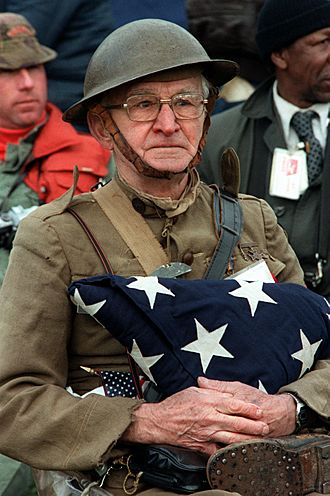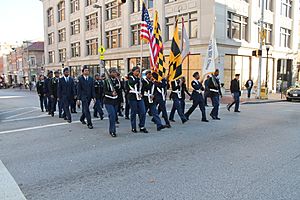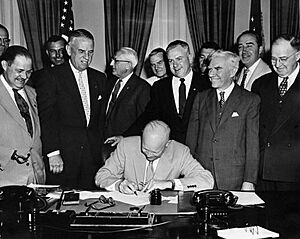Veterans Day facts for kids
Quick facts for kids Veterans Day |
|
|---|---|

U.S. World War I veteran Joseph Ambrose (1896–1988) at the Vietnam Veterans Memorial parade in 1982. He is wearing his old uniform and holding the flag from his son's casket. His son died in the Korean War.
|
|
| Also called | Armistice Day |
| Observed by | United States |
| Type | National |
| Celebrations | Veterans Day parades |
| Date | November 11 |
| Frequency | Annual |
| Related to | Remembrance Day |
Veterans Day is a special day in the United States when we honor all the brave men and women who have served in the United States Armed Forces. It happens every year on November 11. This day is a federal holiday, meaning many people have the day off from work or school.
This important day used to be called Armistice Day. It marks the end of World War I, a very big war that stopped on the 11th hour of the 11th day of the 11th month in 1918. Many other countries also celebrate similar holidays on this date, like Remembrance Day. In 1954, the name was changed to Veterans Day to honor all veterans, not just those from World War I.
It's good to know that Veterans Day is different from other holidays that honor military members. Memorial Day, in May, honors those who sadly died while serving our country. Armed Forces Day, also in May, celebrates those who are currently serving. Veterans Day is unique because it thanks everyone who has ever worn a uniform to protect our nation.
Contents
History of Veterans Day
The First Armistice Day
The very first Armistice Day was celebrated on November 11, 1919. President Woodrow Wilson shared his thoughts on what this day meant for Americans. He spoke about how the war had ended and how it gave the world a chance to rebuild in peace. He also mentioned the great pride Americans felt for the heroes who served and the victory that brought new hope for freedom and fairness among nations.
Making it a Holiday
Over time, people wanted to make Armistice Day an official holiday. On June 4, 1926, the U.S. Congress asked President Calvin Coolidge to make sure November 11 was celebrated every year. Then, on May 13, 1938, Congress passed a law. This law officially made November 11 a legal holiday. It was called 'Armistice Day' and was meant to celebrate world peace.
From Armistice Day to Veterans Day
After World War II, a veteran named Raymond Weeks from Birmingham, Alabama, had a great idea. He wanted a national holiday to honor all veterans, both those who were still alive and those who had passed away. He wanted this holiday to be on Armistice Day. Raymond Weeks worked hard to make this happen. He even spoke with General Dwight D. Eisenhower, who later became president and supported the idea. Weeks organized the first national celebration in 1947. He continued to lead these events every year until he passed away in 1985. Many years later, President Reagan honored Raymond Weeks for his important role in creating this national holiday.
A New Name for a Special Day
A U.S. Representative named Ed Rees helped make this idea a law. President Dwight D. Eisenhower signed the bill on May 26, 1954. This officially changed Armistice Day to Veterans Day. The name change happened on June 1, 1954. This new name made sure that the holiday honored all veterans from all wars and times of peace.
When We Celebrate Veterans Day
For a while, the date of Veterans Day changed. In 1971, it was moved to the fourth Monday in October. This was part of a law called the Uniform Monday Holiday Act. However, many people felt strongly that Veterans Day should always be on November 11. So, in 1978, the holiday was moved back to its original date. Now, it is always celebrated on November 11. If November 11 falls on a weekend, federal workers usually get the closest weekday off.
How Veterans Day is Observed
Since Veterans Day is a federal holiday, many students and workers in the U.S. have the day off. If November 11 is on a Saturday, the holiday might be observed on the Friday before. If it's on a Sunday, it's usually observed on the following Monday. This helps more people participate in the celebrations.
On this day, many federal government offices are closed, and mail delivery takes a break. It's a time for communities to come together. Many towns hold parades and special events to thank veterans. Sometimes, people observe two minutes of silence at 2:11 PM Eastern Standard Time to remember the end of World War I.
Special Traditions
Veterans Day is very close to the birthday of the United States Marine Corps, which is on November 10. Because of this, the Marines often celebrate both days together. Some people have suggested that Veterans Day and Election Day should be combined. This would give citizens a day off to vote, honoring our democratic rights.
How to Spell Veterans Day
You might see 'Veterans Day' spelled in different ways, sometimes with an apostrophe (like Veteran's Day or Veterans' Day). However, the official way to spell it is without an apostrophe: Veterans Day. The U.S. Department of Veterans Affairs explains that it's not a day that 'belongs' to veterans. Instead, it's a day for honoring all veterans. So, no apostrophe is needed!
See also
 In Spanish: Día de los Veteranos (Estados Unidos) para niños
In Spanish: Día de los Veteranos (Estados Unidos) para niños



